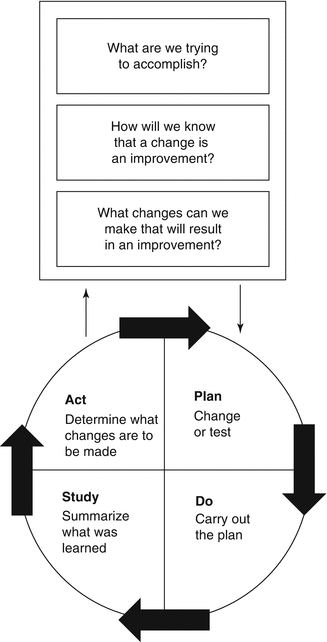
Fig. 3.2
The Model for Improvement, which incorporates the plan-do-study-act cycle (Adapted from Langley et al. [6])
1.
What are we trying to accomplish?
2.
How will we know that a change is an improvement?
3.
What change can we make that will result in an improvement?
The wide use of the PDSA cycle and the Model for Improvement in healthcare is the direct result of their elegance and simplicity, as well as to the transferability and application of these approaches across multiple care and non health settings.
Improvement collaboratives are another approach to quality improvement. A quality improvement collaborative consists of “multidisciplinary teams from various healthcare departments or organizations that join forces for several months to work in a structured way to improve their provision of care” [10].
One of the first uses of collaboratives was the Northern New England Cardiovascular Disease Study Group in 1986 [11]. Their continuing and effective use in cardiovascular care is described in a systematic review of the management of heart failure, published in 2006, 20 years after this management process was begun. This review concluded that collaboratives “[have] significant potential to improve the outcomes of patients, particularly those with [heart failure] and chronic cardiovascular disease. The success and widespread adoption of collaboratives are directly related to the growing trust, respect, and data sharing among like-minded clinicians. This trust leads to meaningful exchanges and insights among experts and peers who then apply best practices to improve their care. Learning collaboratives can also use the PDSA approach [11] and are arguably the most effective way for systems to rapidly learn from each other about improving their process and patient outcomes.
Improvement collaboratives are successful and popular ways of improving health service delivery in disciplines ranging from cystic fibrosis, to heart failure, to trauma care [12, 13]. However, collaboratives are expensive and their results are difficult to measure with traditional epidemiological methods [14].
In the 1980s the Motorola Corporation developed the Six Sigma Methodology [15]. Six Sigma starts with a process mapping activity that involves elements of defining what a business does, assigning responsibilities, identifying performance standards, and deciding how success will be determined (see below). After these critical elements have been defined, Six Sigma analyzes each through the DMAIC methodology (Define, Measure, Analyze, Improve, and Control) [16].
“Lean,” also known as “lean manufacturing,” “lean enterprise,” or “lean production,” is a CQI approach that considers as wasteful any resources that are allocated to any goal other than creating value for the customer and that are thus targets for elimination [17]. Value is defined from the customer’s perspective and includes any action or process for which a customer would be willing to pay.
For many, Lean is an approach to improvement that helps to identify and steadily eliminate waste in processes (or muda, in Japanese). As waste is eliminated, quality improves and production time and costs are reduced. Essentially, lean is centered on preserving value with less work. Lean optimizes the trade-off between productivity and quality and highlights the axiom that improved quality translates to improved profitability, or good quality is good business.
Quality Improvement Tools
Several CQI tools can help improve pediatric cardiac care and surgery [18]. The most relevant tools for pediatric cardiac surgery are listed in detail below and include checklists, process maps, Ishikawa diagrams, run charts, and control charts.
Checklists
The checklist has received the most attention (and press) for improving patient safety. Evidence supports greater adoption of checklists in surgery [19] and in other medical specialties [20–22]. In June 2008, the Safe Surgery Saves Lives Initiative of the World Health Organization (WHO) released the WHO Surgical Safety Checklist. In a little more than 2 years, more than 3,900 hospitals in more than 122 countries were registered in the Initiative. Of these 3,900 hospitals, more than 1,800 have reported using a checklist in at least one operating room [23].
The Dutch SURPASS study, conducted from October 2007 to March 2009, found that hospitals using checklists had surgical complication rates that were more than one-third lower, and death rates that were almost one-half lower (from 1.5 to 0.8 %), than they were in hospitals not using checklists [24].
Researchers at Stanford found that the observed-to-expected mortality ratio declined from 0.88 in quarter one, to 0.80 in quarter two, with the use of a modified version of the WHO Surgical Safety Checklist [25]. The use of checklists also improved communication among the surgical team, and thus the quality of care. Quality was measured by the frequency with which staff reported “Patient Safety Never Events” (i.e., the kind of events that should “never happen”). The number of Patient Safety Never Events related to errors or complications decreased from 35.2 to 24.3 %.
The website Safesurg.org provides resources for implementing the WHO checklist or for modifying an existing checklist. Modified checklists created by other institutions can also be downloaded (http://www.who.int/patientsafety/safesurgery/checklist/en/). [26] Modifying checklists to fit local practices and needs is encouraged to enhance acceptance.
Although checklists have been widely adopted, their effectiveness has been highly variable if they are casually applied only as tick-box forms and in a top down approach [27]. Ineffective top-down engagement and inauthentic partnering with clinicians inhibits positive behavior change and encourages normalized deviance [28]. Introducing a checklist in an environment characterized by a lack of trust causes clinicians to feel jeopardized professionally and personally, encourages gaming and lead to marginal to no improvement of care or outcomes [29]. Effective adoption requires local championship, sustained clinician engagement, and a commitment to interprofessional teamwork [30, 31].
Process Maps
A process map or flowchart is a visual representation of the care process that is created with information provided by team members. The process mapping exercise can help clinicians clarify through visualization the complex and many step process of their environment and determine what they want to do to improve it. The exercise helps clinicians make assumptions and expectations explicit and can provide insight into how to improve the process of care or to overcome barriers to its improvement [32].
A high degree of process awareness often drives the design changes needed to sustain improvement. Process mapping describes precisely what an individual provider is required to do and when, in terms of cognitive processes, actions, or both, to achieve the system’s goal. Data are collected from observations or interviews that carefully break down complex clinical processes into discrete, measurable, and clear tasks [32]. Team members can gain insights into how they and their colleagues perceive the same tasks and hopefully come to a shared understanding of the process.
Ultimately, improving patient outcomes requires appreciating the inherent links between structure, process and outcomes [33]. Process maps help focus improvement efforts, not solely for the individual provider, but for the entire clinical microsystem. Visualizing the process can also help identify inefficiencies (e.g., parallel or redundant processes that have emerged for whatever reason), clarify roles, and reduce ambiguity among team members, all of which can help coordinate patient care. This process is particularly useful in improving transitions of care and avoiding readmissions and patient bounce back to intensive care and high-dependency units [34, 35].
Process maps can be created at different levels of detail to illustrate the major phases or detailed activities in that process. It is important to map the current process, not the desired process, to identify opportunities for improvement. We have used process mapping in pediatric cardiac surgery to better understand the current process of care (Fig. 3.3) and to summarize the data on near misses and adverse events (Fig. 3.4) [32, 36].
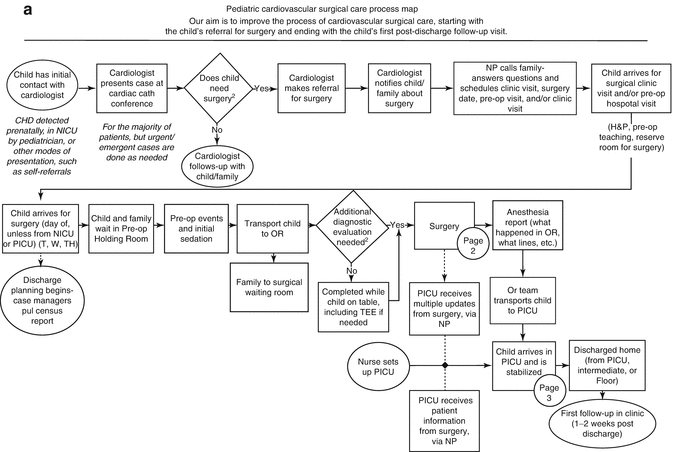
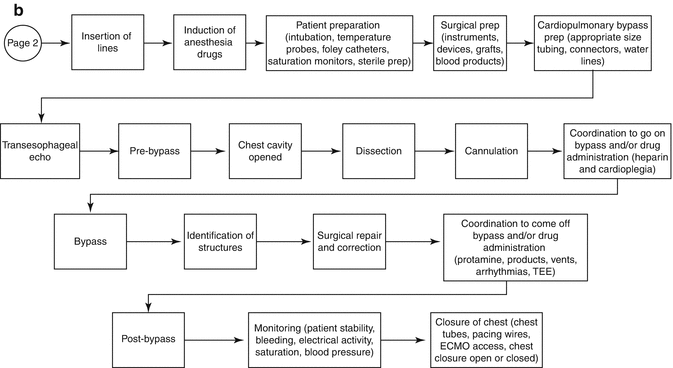
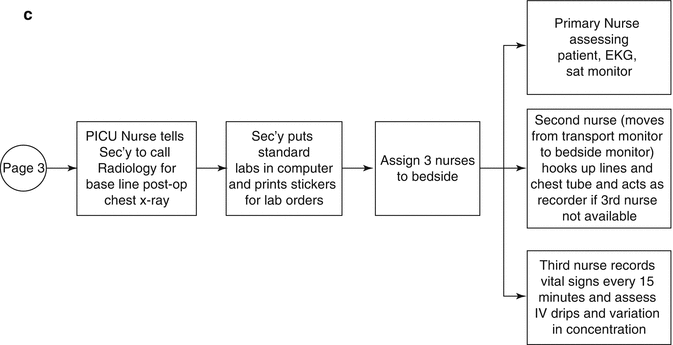
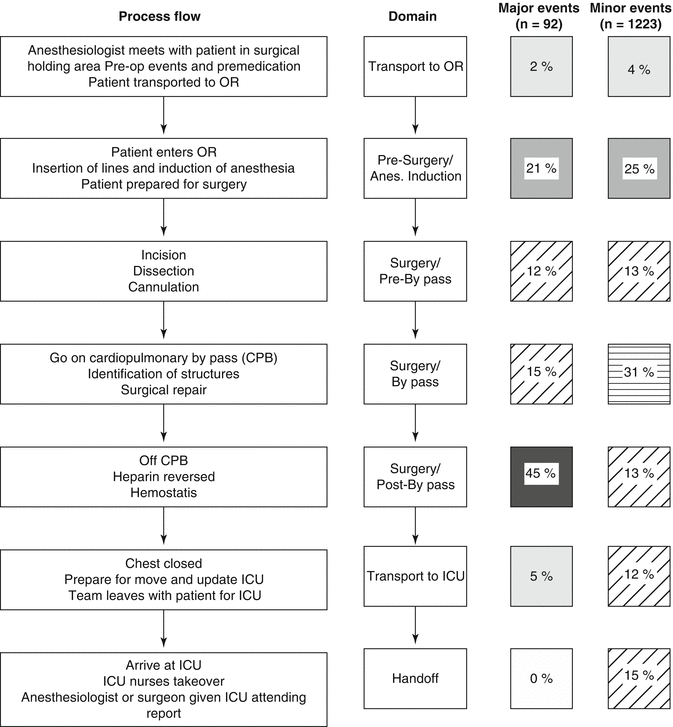



Fig. 3.3
A process map of pediatric cardiac and cardiac surgical care. (a) Preoperative processes. (b) Operative processes. (c) Postoperative processed (Source: Barach and Johnso [32]6). page i13. Used with permission)

Fig. 3.4
A process map showing minor and major adverse event data in pediatric cardiac surgery (Source: Barach et al. [36]. Used with permission)
Ishikawa Diagrams
Ishikawa diagrams, also known as “cause-and-effect diagrams,” “fishbone diagrams,” and “root-cause analyses,” are visual representations of the sources of variation in a process [37]. The diagram is often created by brainstorming with key stakeholders to identify the causes and their effects on a process. The causes are generally allocated to five general categories: place (environment), equipment, procedures (processes), people (patients and providers), and policies (Fig. 3.5). Routine root cause analysis with Ishikawa diagrams can be very powerful in analyzing surgical adverse events. A detailed analysis in one major hospital over 4 years (Table 3.1) established the fact that excellent surgical outcomes depend on appreciating and integrating individual, team, technical, and organizational factors [38].
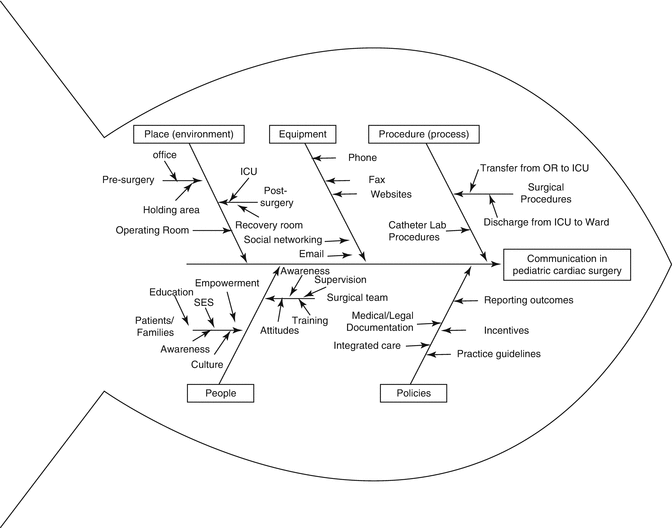

Fig. 3.5
An Ishikawa diagram for pediatric cardiac surgery
Table 3.1
Results of a root cause analysis of process variation of cardiac surgery
Theme | Issues identified |
|---|---|
Failure to recognize or respond appropriately to the deteriorating patient within the required timeframe | Post CABG complications |
Postoperative sepsis | |
Postoperative hyponatremia | |
Workforce availability and skills < div class='tao-gold-member'>
Only gold members can continue reading. Log In or Register to continue
Stay updated, free articles. Join our Telegram channel
Full access? Get Clinical Tree
 Get Clinical Tree app for offline access
Get Clinical Tree app for offline access

|